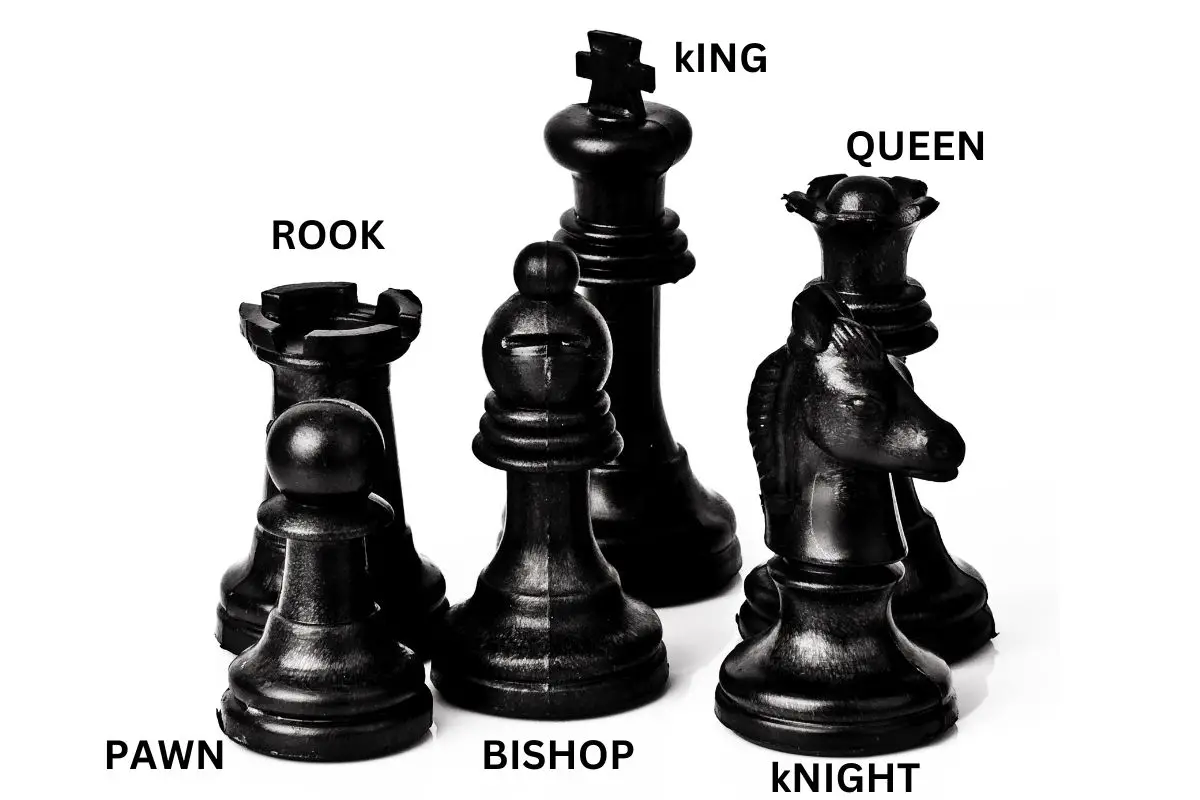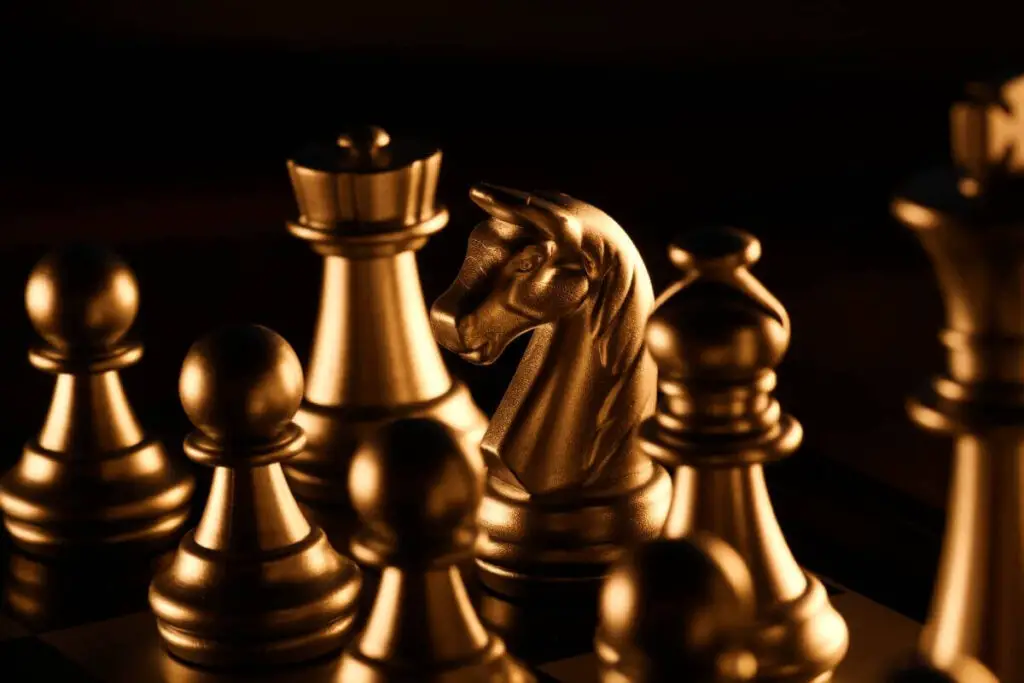Chess is a strategic board game that has been enjoyed by millions of people around the world for centuries. One of the unique aspects of chess is the diverse set of pieces used to play the game.
From the powerful queen to the humble pawn, each piece has its own unique role and value. In this article, we’ll take a closer look at the 16 pieces used in chess and their respective names, giving you a better understanding of this timeless game.
Whether you’re a beginner learning the ropes or a seasoned chess player looking to refresh your memory, this guide will help you master the basic pieces of chess
What Are The 16 Pieces In Chess Called?
Here is a list of the 16 pieces in chess, along with their names:
- King – The most important piece on the board. It is represented by a tall piece with a cross on top.
- Queen – The most powerful piece on the board. It is represented by a tall piece with a pointed top or crown.
- Rook – A piece that can move horizontally or vertically any number of squares. It is represented by a short, stout piece that resembles a tower or castle.
- Bishop – A piece that can move diagonally any number of squares. It is represented by a tall piece with a slanted top.
- Knight – A piece that moves in an “L” shape, jumping over any pieces in its path. It is represented by a horse’s head.
- Pawn – The weakest piece on the board. It moves forward one square at a time, except on its first move, when it can move forward two squares. It is represented by a small piece with a pointed top.
In total, there are 16 pieces on a chess board, with each player having one king, one queen, two rooks, two bishops, two knights, and eight pawns.
Picture showing all 16 chess pieces and their names

How To Set up the 16 Pieces on the Chess Board?
To set up the chess board with all 16 pieces, follow these steps:
- Place the board between the players with a light-colored square on each player’s bottom right corner.
- Place the rooks in the corners of the board.
- Place the knights next to the rooks.
- Place the bishops next to the knights.
- Place the queen on the remaining square of her own color.
- Place the king on the remaining square of his own color.
- Finally, place the pawns in a row in front of all the other pieces.
Remember, the setup should be the same for both players, with the pieces arranged symmetrically across the board. Once the pieces are set up, you’re ready to start the game!
Original Names Of The Chess Pieces
The origins of chess can be traced back over a thousand years, and the original names of the chess pieces varied depending on the culture and region where the game was played. Here are some of the original names of the chess pieces from the earliest versions of the game:
- Advisor – This piece was similar to the modern queen and could move one square diagonally in any direction.
- Chariot – This piece was similar to the modern rook and could move horizontally or vertically any number of squares.
- Elephant – This piece was similar to the modern bishop and could move two squares diagonally.
- Horse – This piece was similar to the modern knight and could move in an “L” shape.
- Foot soldier – This piece was similar to the modern pawn and could move one square forward.
It’s worth noting that these names varied depending on the region and culture where the game was played. For example, in Islamic cultures, the “elephant” was known as the “al-fil,” and the “advisor” was known as the “vizier.” Over time, these names evolved into the more familiar names used in modern chess.
How do the 16 different chess pieces move?
1. Pawn
Pawns are the most numerous and weakest pieces on the chess board. They are represented by small pieces with a pointed top and are placed on the second row of the board at the beginning of the game. Here’s how pawns move:
- Pawns can only move forward one square at a time, except on their first move, when they can move forward two squares.
- Pawns can only capture an opponent’s piece if it is located one square diagonally in front of them.
- Pawns cannot move backwards or sideways, and they cannot jump over other pieces.
- Pawns have a special move called “en passant,” which can be used when an opponent’s pawn moves two squares forward on its first move, and lands on a square next to your pawn. In this case, your pawn has the option to capture the opponent’s pawn “en passant,” as if it had only moved one square forward.
- When a pawn reaches the opposite end of the board, it can be promoted to any other piece except a king. Most players choose to promote their pawn to a queen, as this is the most powerful piece on the board.
Pawns are an important part of the chess strategy, as they can control key squares on the board and help to protect other pieces.
2. King
The king is the most important piece on the chess board and is represented by a tall piece with a cross on top. Here’s how the king moves:
- The king can move one square in any direction: horizontally, vertically, or diagonally.
- The king cannot move into a square that is attacked by an opponent’s piece, meaning that it cannot move into a square that is threatened by an opposing piece.
- The king can never move into check, which means that it cannot be moved into a square that would allow it to be captured by an opponent on their next move.
- The king can also perform a special move called castling. Castling involves moving the king two squares towards a rook, and then moving the rook to the square that the king passed over. However, there are certain conditions that must be met in order to castle, such as no pieces being between the king and rook, and neither the king nor the rook can have moved previously in the game.
As the most important piece on the board, protecting the king is crucial to winning the game. While the king has limited movement capabilities, it is also one of the most powerful defensive pieces on the board.
3. Bishop
The bishop is one of the chess pieces that moves diagonally across the board. Here’s how the bishop moves:
- The bishop can move any number of squares diagonally in a straight line, as long as it is not obstructed by another piece.
- The bishop always stays on the same color square that it started on. That is, a bishop that started on a light-colored square will always move on light-colored squares, and a bishop that started on a dark-colored square will always move on dark-colored squares.
- Bishops can be a powerful piece in the game, especially when they are able to control important diagonals or attack an opponent’s pieces from a distance.
- Bishops can work together with other pieces to create powerful attacks, such as a “bishop pair” that controls both light and dark-colored squares.
Knowing how to effectively use bishops is an important part of developing a successful chess strategy.
4. Queen
The queen is the most powerful piece on the chess board and is represented by a tall piece with a pointed top and a crown. Here’s how the queen moves:
- The queen can move any number of squares diagonally, horizontally, or vertically in a straight line, as long as it is not obstructed by another piece.
- The queen can move in any direction and can move as far as she wants along a diagonal, horizontal, or vertical line, as long as there are no other pieces in her way.
- The queen can be a very powerful piece in the game, as she has the ability to control many squares on the board and attack multiple pieces at once.
- Because of her versatility and power, the queen is often considered the most valuable piece on the board.
Understanding how to effectively use the queen in a game of chess is essential to developing a successful strategy. However, it is also important to protect the queen from being captured, as losing the queen can be a significant setback in the game.
5. Knight
The knight is one of the unique pieces on the chess board and is represented by a piece that looks like a horse’s head. Here’s how the knight moves:
- The knight moves in an “L” shape, meaning that it moves two squares in one direction (either horizontally or vertically), and then one square perpendicular to that direction. This move allows the knight to jump over other pieces on the board.
- The knight is the only piece that can jump over other pieces, making it a powerful piece in certain situations.
- The knight can also be used to attack an opponent’s pieces that may be difficult to reach with other pieces.
- Because of its unique movement pattern, the knight can be used to control important squares on the board that other pieces cannot reach.
Understanding how to use the knight effectively is an important part of developing a successful chess strategy. It is also important to note that the knight’s ability to jump over other pieces makes it more difficult for an opponent to predict its movements, making it a tricky piece to defend against.
6. Rook
The rook is one of the chess pieces that moves horizontally or vertically across the board. Here’s how the rook moves:
- The rook can move any number of squares horizontally or vertically in a straight line, as long as it is not obstructed by another piece.
- The rook is often considered a powerful piece in the game, as it has the ability to control entire ranks or files on the board.
- The rook can also be used to protect other pieces, as it can move to block attacks from opponent’s pieces.
- Two rooks working together can be a powerful combination, as they can control both files and ranks, and potentially control the entire board.
Knowing how to effectively use rooks is an important part of developing a successful chess strategy. It is also important to protect rooks from being trapped or captured, as losing a rook can be a significant setback in the game.
Final Thoughts
In conclusion, understanding the names and movements of the 16 pieces in chess is essential for anyone who wants to become proficient in the game.
Each piece has its own unique movements and abilities, and learning how to use them effectively can greatly improve your chances of winning.
From the humble pawn to the mighty queen, each piece plays a crucial role in the game and mastering their movements is key to success.
By practicing and familiarizing yourself with the pieces and their movements, you can develop a strong chess strategy and improve your overall gameplay. So, whether you’re a beginner or an experienced player, take the time to learn the names and movements of the 16 pieces in chess and take your game to the next level.


